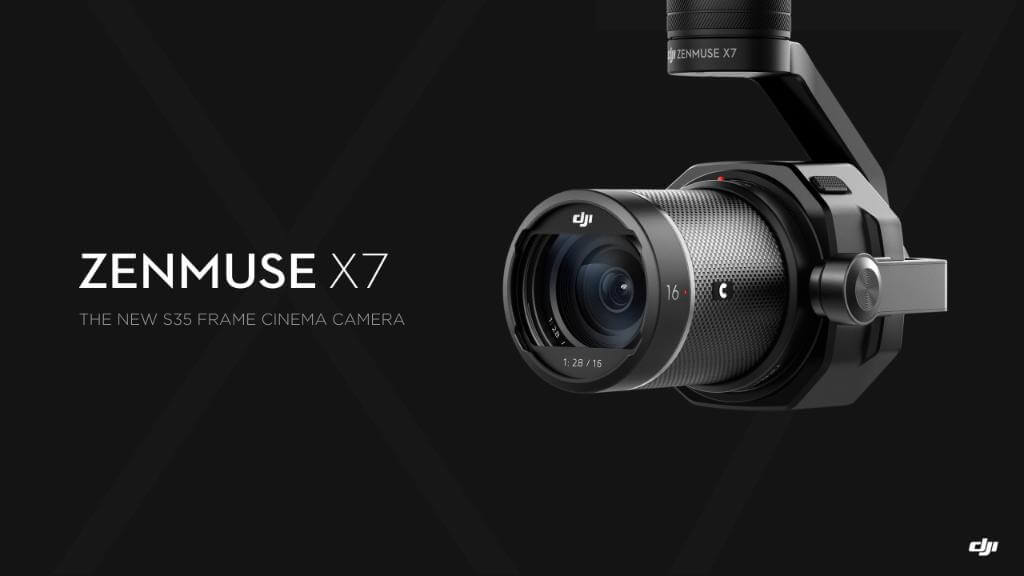In case you missed it, DJI released it’s most advanced gimbal mounted cinematic camera this week with the all new Zenmuse X7.
We reported on the basic features of the Zenmuse X7 on launch day, and now we want to go further into the details of the Zenmuse X7 camera itself and the optional DJI lenses that go with it.
First off, the Zenmuse X7 body has the world’s first Super 35mm camera. It’s because of this Super 35mm sensor in the Zenmuse X7 body that the camera can capture video up to 6K in CinemaDNG and 5.2K in Apple ProRes.
For still photography the Zenmuse X7‘s sensor captures images at 24 megapixels, full frame. DJI’s next model down from the X7, the Zenmuse X5S captures up to 20.8 megapixels and video up to 5.2K at 30 frames per second.
But when we compare the relative size difference of the X7’s Super 35mm sensor with the Micro 4/3 sensor of the Zenmuse X5S the difference is huge.
Obviously the larger capture area with a more sensitive sensor means a big difference in quality of video. But it is also the result of being able to use larger glass allowing higher sensitivity with more light entering the camera which expands the dynamic range to 14 stops versus 12.8 stops on the Zenmuse X5S.
And because the sensor is that much larger than the Zenmuse X5S, the angle of light entering the Zenmuse X7 is enhanced which allowed DJI to design lenses for the Zenmuse X7 that are more compact. DJI took the lens design a step further by incorporating lightweight carbon fiber resulting in an overall camera payload that has minimal impact on the Inspire 2’s 27 minute flight time/battery life.
 So we know the Zenmuse X7 camera body itself is epic. Literally the most powerful camera ever mounted on a professional/industrial drone. But what do we expect from the four prime lenses that DJI has designed for the Zenmuse X7?
So we know the Zenmuse X7 camera body itself is epic. Literally the most powerful camera ever mounted on a professional/industrial drone. But what do we expect from the four prime lenses that DJI has designed for the Zenmuse X7?
First off, as we just said, they’re all prime lenses, meaning fixed focal length. Starting at 16mm and moving to 24mm then 35mm and finally 50mm they all have a maximum aperture of F2.8. For those of us that cut our teeth in photography with digital SLRs and became familiar with a “nifty fifty” 50mm prime lens, this means shallower depth of field.
With the broad stature of Zenmuse lens apertures wide open, you’re letting in a lot of light which explains the outperformance of the X7 in low light situations. Better detail in shadows, less blowout in highlights.

Pairing the Zenmuse X7 with an aerial platform means your only choice right now is the Inspire 2. But DJI has already indicated that “the X7 will be compatible with more DJI products in the future.” What that means is anyone’s guess, but we expect a handheld gimbal mount such as the Osmo is already developed. And looking at a massive test-drone we uncovered a few months ago that is specifically built for Hollywood we know there is definitely more to come.
We won’t go into great detail comparing the Inspire 1 and Inspire 2 drones (DJI has already done that nicely here) other than to say that because the Inspire already has such a foothold in Hollywood and media productions that the Inspire 2 had to be created knowing the X7 was in development simply to have the best aerial platform for the X7 camera.
DJI product development doesn’t take place in a vacuum. Hollywood cinematrographers are absolutely pushing DJI for more and better all the time. What is most surprising about the Inspire 2 / Zenmuse X7 combination is the cost. Or maybe more specifically, the value. As a flying platform, the Inspire 2 is only twice the cost of the Phantom 4 Pro yet the components, what’s included and the potential with the Inspire 2 is much more than a multiple of two. Yes you have to add a camera to the Inspire, but even with the Zenmuse X7 and all four lenses you’re still under $10,000. You might think that the Inspire 2 and the most powerful aerial camera and lens combination is only for serious Hollywood teams, but at that price you’re going to see more pilots and photographers who are serious about their craft upgrading big time.
Third Party Filters
DJI hasn’t added any filters to the X7 accessories section on the DJI Store, but the Zenmuse X7 is compatible with 3rd party lens filters with a diameter of 46mm and a that weigh 10-12 grams. Filter thickness can be no more than 4.4mm, excluding threads.
The two highest resolution recording modes of the Zenmuse X7 are the result of integrating CinemaDNG and/or Apple ProRes formats into your capture. They aren’t accessible to the filmmaker without purchasing licenses. CinemaDNG activation is an additional $1000 with your X7, while Apple ProRes is $500. The two can be bundled for a $200 savings for a total cost of $1300.
The final piece in the Zenmuse X7 puzzle is tacking on DJI Care Refresh. We’ve written about DJI Care many times, must mostly in the context of DJI’s consumer/recreational drones. DJI Care Refresh for the Zenmuse X7 is $499 and includes two replacement units within one year. The replacement will be either new or ‘equivalent to new’ in performance and reliablility.
The first DJI Care Refresh replacement for the X7 camera is $379 and the second costs $529. Full details here.








